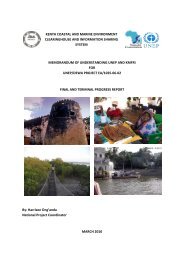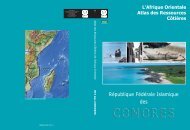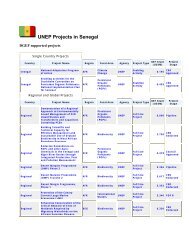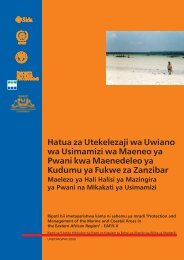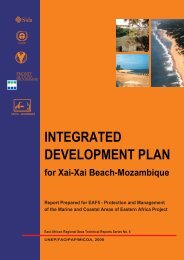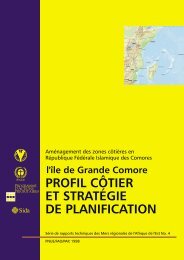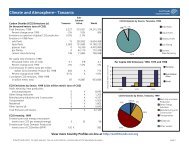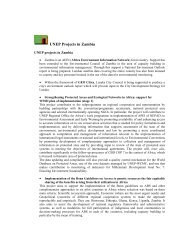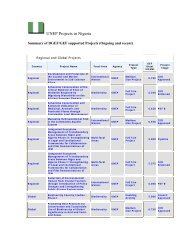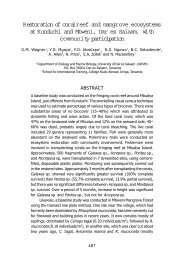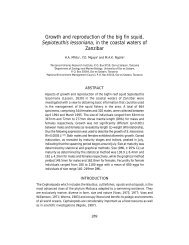Please Click to download [English] - GRID Africa GeoPortal - UNEP
Please Click to download [English] - GRID Africa GeoPortal - UNEP
Please Click to download [English] - GRID Africa GeoPortal - UNEP
You also want an ePaper? Increase the reach of your titles
YUMPU automatically turns print PDFs into web optimized ePapers that Google loves.
NAIROBI CONVENTION CLEARINGHOUSE AND<br />
INFORMATION SHARING SYSTEM<br />
E-NEWSLETTER<br />
ENHANCING SHARING, EXCHANGE AND ACCESS TO INFORMATION<br />
September– December 2007 Volume 1, Issue 1<br />
The Mauritius regional training workshop<br />
F<br />
ollowing the May 2006 regional stakeholders<br />
workshop on the implementation of the<br />
Nairobi Convention Clearinghouse and information<br />
sharing system, a review meeting of the<br />
clearinghouse was held in Mauritius from 13‐17<br />
August 2007. The review was held during a subregional<br />
training workshop on GIS concepts<br />
necessary for development of the Clearinghouse<br />
mechanism and information system. The training<br />
was directed at participants from national public<br />
administration and technical agencies participating<br />
in the development of the Clearinghouse mechanism<br />
in Kenya, Tanzania, Mozambique, Madagascar,<br />
Comoros, Mauritius, South <strong>Africa</strong> and Seychelles.<br />
The workshop was graciously opened by the Secretary <strong>to</strong><br />
the Cabinet and Head of the Mauritius Civil Service Mr. S.<br />
C. Seeballuck. In his speech, Mr. Seeballuck asked the<br />
participants <strong>to</strong> begin <strong>to</strong><br />
Inside this issue:<br />
• Mauritius Workshop 1<br />
strategize on the long term<br />
sustainability of the Nairobi<br />
Convention Clearinghouse<br />
• Way forward after the 2<br />
and Information systems at<br />
Mauritius Workshop<br />
the national level. He<br />
• Miles<strong>to</strong>nes of the 2<br />
Clearinghouse Mechanism<br />
further posed very critical<br />
questions on the way<br />
• Nairobi Convention 3 forward for the<br />
COP5 Decisions and<br />
Ministerial Declaration Clearinghouse, which<br />
constituted the basis of the<br />
• Launch of the<br />
4<br />
Clearinghouse<br />
review (see s<strong>to</strong>ry on the<br />
outcome and way forward<br />
5<br />
of the Mauritius training).<br />
• Data organization in the<br />
database<br />
• Upcoming Events 6<br />
Mr. Seeballuck was accompanied by among others senior<br />
representatives of the Government<br />
of Mauritius, UNDP Country Office,<br />
the Indian Ocean Commission, the<br />
University of Mauritius the Direc<strong>to</strong>r<br />
of the Mauritius Oceanography<br />
Institute Mr. M. Bhikajee, and the<br />
Nairobi Convention Focal Point in<br />
Mauritius Mr. J. Seewoobaduth. He<br />
was welcomed by the Direc<strong>to</strong>r of<br />
the Mauritius Meteorological<br />
Services, Mr. Y. Boodhoo and the<br />
national coordina<strong>to</strong>r of the Nairobi<br />
Convention Clearinghouse mechanism in Mauritius Mr.<br />
M. Beebeejaun.<br />
Opening speech by Mr.<br />
Seeballuck, Secretary <strong>to</strong> the<br />
Cabinet and Head of Mauritius<br />
Civil Service<br />
A group pho<strong>to</strong>graph of the participants in the Mauritius<br />
workshop, 13-17 August 2007<br />
The training aimed at enhancing the capacity and<br />
technology transfer efforts of the United Nations<br />
Environment Programme (<strong>UNEP</strong>) necessary for the<br />
support, cooperation, coordination, access and sharing<br />
of environmental data amongst the developing countries
……. GIS concepts and Portal development<br />
in <strong>Africa</strong>. The training was held at the Regional<br />
Meteorological and Research Centre located at the<br />
Mauritius Meteorological Services in Vacaos.<br />
In his address, <strong>UNEP</strong> representative Mr. Mwangi Theuri,<br />
highlighted the key benefits of the clearinghouse and<br />
information system. He pointed out that the<br />
Clearinghouse will enable access <strong>to</strong> relevant coastal and<br />
marine environmental issues, enable identification of<br />
priority areas of action, raise awareness on key<br />
environmental issues, enhance visibility of the Western<br />
Indian Ocean region, and increase collaboration among<br />
partners and stakeholders.<br />
The Nairobi Convention Clearinghouse is destined <strong>to</strong> be a<br />
sustainable first port of call for information on the coastal<br />
and marine environment in the Western Indian Ocean<br />
region, providing accurate and relevant data and<br />
information for improved management and protection of<br />
the coastal and marine environment in the Region. The<br />
Clearinghouse responds <strong>to</strong> Decision 4/8 (July 2004) of the<br />
Nairobi Convention fourth Conference of Parties.<br />
Under Decision 4/8, Governments of the region<br />
recognized that access <strong>to</strong>, and use of the increasing<br />
diverse, comprehensive data and information on the<br />
coastal and marine environment is crucial in order <strong>to</strong> deal<br />
with the vast array of policy, management, scientific and<br />
other practical issues of sustainable development. The<br />
Parties tasked the Convention Secretariat with the<br />
establishment of an information system <strong>to</strong> meet the<br />
needs of the Governments in implementing the work<br />
programme of the Convention.<br />
Based on the individual responses at the end of the training,<br />
participants resolved <strong>to</strong> develop their national coastal and<br />
marine clearinghouse nodes, publicize the clearinghouse<br />
benefits, and articulate the technical and functional<br />
capabilities of the clearinghouse network. Further, they<br />
agreed <strong>to</strong> use the technology of the <strong>GeoPortal</strong> Toolkit in order<br />
Implementation of the Nairobi Convention<br />
Clearinghouse: Miles<strong>to</strong>nes<br />
<strong>UNEP</strong>, through its Division of Early Warning and Assessment<br />
(DEWA) with support and collaboration from the <strong>UNEP</strong>/GEF<br />
WIOLaB project (Addressing Land‐based Activities in the<br />
Western Indian Ocean), the Nairobi Convention Secretariat<br />
and participating national institutions is implementing<br />
environmental clearinghouses for Seychelles, Mauritius,<br />
Comoros and Madagascar, including the coastal and marine<br />
region of the mainland countries of Kenya, Tanzania,<br />
Mozambique and South <strong>Africa</strong>.<br />
Each national clearinghouse will be cus<strong>to</strong>mized <strong>to</strong> enable<br />
geospatial analysis, statistical analysis, geo‐feature modeling<br />
(3D), data conversion <strong>to</strong> and from various formats, projection<br />
and coordinate transformation, viewing or visualizing,<br />
specialized data processing (for remote sensing, GPS, etc.),<br />
data acquisition and maintaining. The national clearinghouses<br />
will also act as national nodes for the Global Programme of<br />
Action for the protection of the marine environment from<br />
land based source of pollution (<strong>UNEP</strong>/GPA programme) in the<br />
Eastern and Southern <strong>Africa</strong> region.<br />
Way forward after the Mauritius training<br />
As well stated in his speech during the opening of the one<br />
week training workshop on the development of the Nairobi<br />
Convention Clearinghouse mechanism (August 2007), the<br />
Secretary <strong>to</strong> the Cabinet and Head of the Mauritius Civil<br />
Service Mr. S. C. Seeballuck challenged the participants <strong>to</strong><br />
endeavor <strong>to</strong> meet the needs of a wide cross‐ section of<br />
people, while developing the Clearinghouse among them<br />
politicians, administra<strong>to</strong>rs, planners, resource managers,<br />
scientists and the general public. In so doing, he said, this<br />
would effectively translate in<strong>to</strong> a better understanding of the<br />
outputs of the clearinghouse mechanism by all key players in<br />
the Government and the private sec<strong>to</strong>r.<br />
As a first step <strong>to</strong>wards addressing these concerns Mr.<br />
Seeballuck tasked the countries with four major concerns<br />
focusing on streamlining the technological development of the<br />
clearinghouse mechanism, strategies for improved<br />
cooperation and coordination with stakeholders and partners,<br />
the question of facilitating an enabling environment for<br />
integration of data through the optimal use of international<br />
metadata standards, and strategies required <strong>to</strong> achieve<br />
national and regional ownership of the Clearinghouse.<br />
Page 2<br />
The Madagascar Working Group during the Clearinghouse<br />
Mechanism planning meeting in Antananarivo<br />
In line with many ongoing projects in the Western Indian<br />
Ocean region, activities are implemented on a cost‐sharing<br />
basis, i.e. the collaborating agency provides the project with<br />
infrastructure and human resources, while <strong>UNEP</strong> and Partners<br />
arranges for the purchase of equipment and software support,<br />
training, a budget <strong>to</strong> accommodate project implementation,<br />
and overall project guidance.<br />
Scooping missions in several countries were carried out in the<br />
months of May and June 2007 <strong>to</strong> ascertain the existing<br />
technologies and ICT infrastructure in participating institutions<br />
and agree upon national level activities. Memoranda of<br />
understanding have been negotiated with the countries for<br />
implementation of national level activities.
On another development, the Nairobi Convention<br />
Clearinghouse and information sharing system was launched<br />
during the 5th Conference of Parties of the Convention held<br />
in Johannesburg, South <strong>Africa</strong>, on 7th and 8th November<br />
2007.<br />
The Clearinghouse mechanism provides a shared–service<br />
platform of accessing resources while being responsive <strong>to</strong><br />
users needs. It marks a drastic change from operating largely<br />
in isolation or in limited bilateral partnerships <strong>to</strong> one where<br />
Key Decisions of the 5th Conference of Contracting<br />
Parties <strong>to</strong> the Nairobi Convention<br />
Volume 1, Issue 1<br />
• Decision CP5/6 on strengthening partnerships and<br />
institutional mechanism including the strengthening of the<br />
Nairobi Convention Regional Coordinating Unit based in<br />
Seychelles;<br />
• Decision CP5/7 on Small Island Developing States<br />
adaptation <strong>to</strong> climate change including of risks of cyclones<br />
and sea level rise;<br />
• Decision CP5/8 on support <strong>to</strong> Somalia in her efforts <strong>to</strong><br />
improve environmental management; and<br />
• Decision CP5/9 urging Contracting parties <strong>to</strong> enhance the<br />
financial sustainability of the Convention.<br />
A joint Conference of Parties for the Abidjan Convention and<br />
the Nairobi Convention was held in Johannesburg, South<br />
<strong>Africa</strong> from 5–8 November 2007 <strong>to</strong> deliberate, discuss and<br />
map the way forward for the two Conventions.<br />
Firstly, in the Nairobi Convention Conference of Parties,<br />
ministers and heads of delegation acknowledged a number of<br />
important miles<strong>to</strong>nes carried out under the Convention. They<br />
acknowledged among others the:<br />
a. Importance of the Nairobi Convention, its pro<strong>to</strong>cols and<br />
its Action Plan as essential instruments for the promotion<br />
of sustainable development in the Region and the need<br />
for their continuous review within the global context;<br />
b. Progress made in the implementation of the <strong>UNEP</strong>/GEF<br />
Project “Addressing Land‐based Activities in the Western<br />
Indian Ocean (WIOLAB)”, including its key outputs;<br />
c. Establishment of the Nairobi Convention Clearinghouse<br />
and Information sharing system <strong>to</strong> enhance sharing,<br />
exchange and access <strong>to</strong> data and information;<br />
d. The important contributions of <strong>UNEP</strong>, UNIDO, IMO,<br />
UNDP, FAO, UNESCO and World Bank as the executing<br />
agencies of various marine ecosystem projects; and<br />
e. The contribution and work of other partners, including<br />
the IUCN, WWF, Western Indian Ocean Marine Sciences<br />
Association (WIOMSA), Wildlife Conservation Society<br />
(WCS) and the Consortium for Conservation of Coastal<br />
and Marine Ecosystems in the Western Indian Ocean<br />
(WIO‐C);<br />
Secondly, the ministers and heads of delegation representing<br />
their Governments made the following key decisions:<br />
• Decision CP5/1 on the new Work Programme of the<br />
Nairobi Convention for the 2008‐2011 period focusing on,<br />
assessments, management, coordination, legal aspects,<br />
information sharing, raising awareness and cooperation<br />
with partners;<br />
• DecisionCP5/2 focusing on protection of ecosystems and<br />
endangered species by endorsing the use of ecosystem<br />
based management approach;<br />
• Decision CP5/3 on assessment and moni<strong>to</strong>ring activities<br />
regarding projects and programmes with transboundary<br />
effects;<br />
• Decision CP5/4 directed <strong>to</strong>wards enhancing the revision<br />
of Nairobi Convention and its related pro<strong>to</strong>cols<br />
A section of participants during the joint Conference of<br />
Contracting Parties <strong>to</strong> the Abidjan and Nairobi Conventions,<br />
Johannesburg, South <strong>Africa</strong>, 5-8 November 2007<br />
Abidjan Convention and Nairobi Convention<br />
Joint Ministerial Declaration<br />
On 8 November 2007, during the joint Conference of Parties of<br />
the Abidjan and Nairobi Conventions, a joint ministerial<br />
declaration was made by Government ministers on 12 priority<br />
areas:<br />
1. To fully implement the Abidjan Convention and Nairobi<br />
Convention and their pro<strong>to</strong>cols;<br />
2. To strengthen and build upon existing national and<br />
regional institutions and frameworks for the<br />
implementation of national and regional strategies;<br />
3. To undertake strategic and other environmental<br />
assessments of activities that may have adverse impact on<br />
the coastal and marine environment;<br />
4. To undertake strategic environmental assessments prior<br />
<strong>to</strong> exploitation and production of hydrocarbons;<br />
5. To raise awareness at the highest political level of the<br />
importance of the implementation of Article 76 of the<br />
1982 United Nations Convention on the Law of the Sea;<br />
6. To develop programmes anchored in the large marine<br />
ecosystems programmes and their evolving commissions;<br />
7. To promote cooperative and collaborative actions with<br />
multi stakeholder partnerships <strong>to</strong> integrate marine and<br />
coastal environment activities;<br />
8. To take appropriate measures <strong>to</strong> prevent, abate, combat<br />
and <strong>to</strong> the fullest possible extent mitigate coastal and<br />
marine pollution;<br />
9. To encourage states sharing river basins with the<br />
Page 3
espective Convention countries <strong>to</strong> accede or<br />
participate in the Conventions;<br />
10. To strengthen the financial sustainability of the<br />
Conventions;<br />
11. To explore the possibilities of joint programming and<br />
holding meetings or conferences of the Parties of the<br />
Abidjan Convention and the Nairobi Convention<br />
<strong>to</strong>gether so as <strong>to</strong> strengthen regional capacity <strong>to</strong><br />
manage shared marine and coastal resources in sub‐<br />
Saharan <strong>Africa</strong>; and<br />
12. Urged national and international institutions, the<br />
private sec<strong>to</strong>r, bilateral donors and multilateral<br />
funding agencies <strong>to</strong> support the implementation of<br />
the two Conventions<br />
Launch of the Nairobi Convention<br />
Clearinghouse: Verbatim speech by the Minister<br />
of Environment of the Comoros<br />
DISCOURS DU LANCEMENT DU CENTRE D’ECHANGE DE<br />
DONNEES ET D’INFORMATIONS POUR LA CONVENTION DE<br />
NAIROBI<br />
Monsieur l’Ambassadeur de France<br />
Monsieur l’Ambassadeur de Seychelles<br />
Monsieur le secrétaire permanent de Kenya<br />
Monsieur le Directeur Général de Sud Afrique<br />
Monsieur le Directeur Général de Mozambique<br />
Messieurs les chefs de délégués de Tanzanie, Maurice et<br />
Madagascar<br />
Honorables invités,<br />
Mesdames, Messieurs,<br />
ASSALAME ANLAYKOUM<br />
La Décision 4/8 de juillet 2004 de la Quatrième conférence<br />
des parties contractantes COP de la convention de Nairobi<br />
a confié au secrétariat de la Convention la tache de la mise<br />
en place d’un système d’information qui facilitera la pleine<br />
participation des pays de l’océan indien occidental en<br />
permettant à ces derniers de bénéficier des activités<br />
nationales et transfrontalieres, techniques<br />
environnementales, juridiques et politiques primordiales<br />
pour le développement durable de leur environnement<br />
marin et côtier. En se basant sur cette décision, le projet<br />
WIO‐LaB, soutenu par la Division d’Alerte rapide et<br />
Evaluation du PNUE (PNUE/DEWA) s’est engagé à<br />
accomplir cette tache en transformant le système de<br />
transformation en ligne existant de la Convention de<br />
Nairobi en un Centre d’échange de données et<br />
d’informations. Ce dernier servira en même temps de<br />
Centre régional d’échange de données et d’information du<br />
Plan d’Action Mondial (PAM).<br />
A travers la Division d’Alerte rapide et Evaluation du PNUE<br />
(PNUE/DEWA) et le projet <strong>UNEP</strong>/GEF WIO‐LaB intitulé «<br />
Atténuation de l’impact néfaste des activités terrestres sur<br />
l’environnement marin et côtier de l’Océan Indien<br />
occidental, l’<strong>UNEP</strong> appuie la mise en oeuvre du Centre<br />
d’échange d’information dans les pays de la région<br />
notamment : Seychelles, Maurice, Comores, Madagascar,<br />
Kenya, Tanzanie, Mozambique et Afrique du Sud.<br />
Le Centre d’échange d’information (CHM) servira en tant<br />
que source première d’informations durable sur<br />
l’environnement marin et côtier dans la région de l’océan indien<br />
occidental. Il constituera une plate forme de données et<br />
d’informations pertinentes et fiables y compris des données<br />
géospatiales, socioéconomiques, océanographiques et<br />
biophysiques. Le système appuiera également la collecte de<br />
données et d’informations pertinentes à partir des centres<br />
nationaux. Il assurera un accès rapide et comprendra un moteur<br />
de recherche. Le Centre d’Echange d’Information permettra<br />
aussi de développer un environnement favorable aux<br />
évaluations et comprendra un forum de discussion pertinent<br />
pour <strong>to</strong>us les acteurs.<br />
La mise en place d’un Centre d’Echange de données dans mon<br />
pays, permet à mon ministère de disposer d’un outil efficace qui<br />
contribue à l’amélioration des connaissances scientifiques<br />
approfondies en vue de promouvoir une politique de gestion<br />
durable de notre environnement dont mon pays a pleinement<br />
besoin en particulier et la région en générale. Il aura pour rôle<br />
de faciliter l'accès aux données et à l'information<br />
environnementales pour une planification stratégique et une<br />
prise de décision appropriée pour les acteurs de développement<br />
durable.<br />
La mise en place d’un Centre d’échange de données dans le<br />
cadre de la Convention de Nairobi, nous permettra d’organiser<br />
l’information et de la rechercher de manière optimale en cas de<br />
besoin. Retrouver les renseignements voulus au moment voulu<br />
pose souvent d’énormes difficultés et parfois l’existence même<br />
d’une donnée est ignorée faute<br />
de l’avoir bien classifiée et de<br />
pouvoir la rechercher de manière<br />
optimale. Le CHM de la<br />
Convention de Nairobi est là pour<br />
répondre à ce genre de problème<br />
<strong>to</strong>ute en nous permettant aussi<br />
de valoriser l’information en<br />
obtenant de produits à valeur<br />
ajoutée (analyses, calculs,<br />
Hon. Mme Siti Kassim, Minister of<br />
Agriculture, Fisheries and<br />
Environment of Comoros. She<br />
launched the Nairobi Convention<br />
Clearinghouse mechanism during<br />
the Nairobi Convention COP5<br />
Conference in Johannesburg,<br />
Page 4<br />
références).<br />
Les décideurs politiques, les<br />
administrateurs, les scientifiques,<br />
les chercheurs, les universitaires,<br />
les étudiants, les consultants<br />
nationaux et internationaux, les<br />
ONGs et le public…etc., sont<br />
identifiés comme les utilisateurs potentiels du Centre d’échange<br />
d’information. En effet, en plus d’être un excellent outil pour des<br />
professionnels de la gestion de l’information environnemental,<br />
le Centre d’échange vise aussi à mettre l’accent sur la protection<br />
et l’utilisation rationnelles des ressources naturelles. De plus, il<br />
servira à informer et à éduquer le public, <strong>to</strong>ut en le sensibilisant<br />
aux multiples questions qui ont besoin d’être résolues.<br />
Le Centre d’échange d’information aura parmi ses objectifs<br />
majeurs, le souci de répondre aux besoins exprimés par les<br />
différents programmes d’action nationaux en matière<br />
d’environnement en insistant sur la nécessité d’une bonne<br />
gestion de l’information environnementale en vue de créer des<br />
meilleures conditions d’un développement du potentiel<br />
scientifique et de la connaissance du milieu dans une optique de<br />
gestion et de développement durable. Il sera un des acteurs<br />
principaux de l’inventaire de la diversité biologique, des
essources naturelles et de la connaissance du milieu dans mon<br />
pays.<br />
Les objectifs principaux du Centre d’Echange d’information<br />
passent aussi par la mise en place d’outils modernes permettant<br />
à mon ministère d’élaborer ses schémas d’action en matière<br />
d’environnement et d’avoir une aide précieuse pour ses diverses<br />
prises de décisions. Un autre but important sera la pérennisation<br />
des différents projets et actions du ministère en apportant une<br />
plus grande visibilité et une meilleure gestion de leurs résultats.<br />
Il convient de noter ici, que l’importance capitale de cet outil a<br />
permis à mon ministère de persuader le gouvernement à donner<br />
son aval sur l’intérêt de créer un département du Système<br />
d’Information Géographique (SIG) chargé de la gestion du Centre<br />
d’Echange (CHM).<br />
A savoir que ce dernier servira non seulement à la collecte à<br />
l’analyse et au traitement de données, mais aussi de promotion<br />
et de valorisation de notre patrimoine culturel et sa valeur<br />
<strong>to</strong>uristique au niveau national et régional. Je ne saurai terminer<br />
mon propos sans présenter mes vifs remerciements au<br />
gouvernement sud africain pour l’accueil combien chaleureux il<br />
nous a réservé et pour avoir bien voulu abriter ces présentes<br />
conférences des parties. Je voudrais également remercier<br />
l’ensemble de l’équipe du projet WIO‐LaB, la Division d’Alerte<br />
rapide et Evaluation du PNUE (PNUE/DEWA), pour son<br />
engagement considérable quant à la mise en place du Centre<br />
d’échange d’information de la Convention de Nairobi.<br />
Mes remerciements vont plus particulièrement à l’endroit de<br />
Monsieur Theuri Mwangi pour son engagement technique depuis<br />
le projet EAF/14 (Base de données et Atlas des ressources<br />
côtières et marines), jusqu’à la mise en place du Centre<br />
d’échange d’information de la Convention de Nairobi dans mon<br />
pays. Vive la coopération des pays du sud ouest de l’Océan<br />
Indien et de l’Afrique de l’Est et du Sud saharien.<br />
Data organization in the Clearinghouse<br />
Mechanism database: Techbyte<br />
The Nairobi Convention Clearinghouse and information sharing<br />
system is driven by an Structure Query Language database which<br />
contains a series of related tables s<strong>to</strong>ring metadata with full text<br />
search capability, channels, harvesting, services and users. The<br />
Clearinghouse has the capabilities of offering metadata records,<br />
geospatial mapping, and data management. With additional<br />
cus<strong>to</strong>mization the clearinghouse can offer data analysis leading<br />
<strong>to</strong> assessment and environmental alerts.<br />
The spatial data is s<strong>to</strong>red in an enterprise Spatial Database<br />
Engine geodatabase (SDE) which has been categorized by spatial<br />
coverage ranging from sub‐national, national, sub‐regional and<br />
regional data or metadata. Regional data ranges from Wetland<br />
areas, vegetation cover, ecological zones, ocean currents, etc.<br />
National data and sub‐national data is s<strong>to</strong>red preceded by<br />
country ISO (International Standards Organization) code. For<br />
example, Tanzania data will appear as TZ_Provinces, TZ_Rivers,<br />
TZ_Unguja dolphins, etc. Downloadable data in the<br />
clearinghouse is s<strong>to</strong>red as zip files in a Web Accessible Folder<br />
(WAF), with links icons provided in the metadata records .<br />
The online map viewer is based on Web Map Services (WMS)<br />
that provide links <strong>to</strong> ‘live’ data and maps running on Internet<br />
Map Server that connects <strong>to</strong> a Spatial Database Engine<br />
database. This advanced clearinghouse architecture is<br />
based on international standards from various<br />
organizations, i.e. Open GIS Consortiums (OGC),<br />
International Standards Organization (ISO), Organization for<br />
the Advancement of Structured Information Standards<br />
(OASIS), World Wide Web Consortium (W3C) which assure<br />
its interoperability, and orientation <strong>to</strong>ward implementing<br />
standards‐complying web services. The web solution<br />
(Internet portals and services) allows for multi‐access of<br />
data at a local level, with the capabilities of data<br />
visualization, integration, verification, and modification.<br />
The online map viewer allows the user <strong>to</strong> connect <strong>to</strong> other<br />
existing global or regional clearinghouse services that are<br />
inter‐operable formats and pro<strong>to</strong>cols such as Web Map<br />
Service, Web Feature Service, Web Coverage Service, Web<br />
Map Context, OpenGIS Location Service among others.<br />
The clearinghouse uses the <strong>GeoPortal</strong> technology from<br />
Environmental Systems Research Institute (ESRI). The<br />
Geoportal is a combined technology and services solution<br />
for implementing local, regional, national, and global spatial<br />
data infrastructure (SDI) portals. The ESRI GIS Portal Toolkit<br />
provides all the necessary elements of a successful GIS<br />
Portal through its framework, map viewer, administration,<br />
publishing, and harvesting modules.<br />
Lead National Institutions implementing the<br />
Nairobi Convention Clearinghouse<br />
SEYCHELLES<br />
Lead institution: Pollution control and Environmental<br />
Impacts, Department of Environment, Ministry of<br />
Environment and Natural Resources<br />
National Coordina<strong>to</strong>r: Mr. Justin prosper<br />
MOZAMBIQUE<br />
Lead institution: Institu<strong>to</strong> Nacional de Hidrografiae<br />
Navegaçao (INAHINA)<br />
National Coordina<strong>to</strong>r:Ms. Ana Maria Alfredo<br />
MAURITIUS<br />
Lead institution: Mauritius Meteorological Services (MMS)<br />
National Coordina<strong>to</strong>r: Mr. Mohamadally Beebeejaun<br />
MADAGASCAR<br />
Lead institution: Office National pour l’Environnement<br />
(O.N.E)<br />
National Coordina<strong>to</strong>r:Mr. Jean Roger Rako<strong>to</strong>arijaona<br />
COMOROS<br />
Lead institution: Ministere de l’Agriculture, de la Pêche, et<br />
de l’Environnement (MAPE)<br />
National Coordina<strong>to</strong>r: Mr. Farid Anasse<br />
TANZANIA<br />
Lead institution: Institute of Marine Sciences (IMS)<br />
National Coordina<strong>to</strong>r: Dr Desiderius CP MASALU<br />
KENYA<br />
Lead institution: Kenya Kenya Marine and Fisheries<br />
Research Institute (KMFRI)<br />
National Coordina<strong>to</strong>r: Mr. Harrison Onganda<br />
SOUTH AFRICA<br />
Lead institution: Department of Environmental Affairs and<br />
Tourism (DEAT)<br />
Page 5
Upcoming Events<br />
• 26th November – 5th December 2007: Regional training<br />
Workshop on the Nairobi Convention Clearinghouse<br />
and Information Sharing System portal development<br />
and Data Population, Nairobi, Kenya.,<br />
The Nairobi Convention Region.<br />
Can you identify the countries?<br />
The four-monthly e-newsletter of the Nairobi Convention<br />
Clearinghouse and Information Sharing system aims at informing<br />
stakeholders, national working groups, partners and all<br />
interested persons on the status of the clearinghouse activities.<br />
Readers are encouraged <strong>to</strong> give comments on the newsletter<br />
and its effectiveness as a vehicle for information exchange. All<br />
communication should be directed <strong>to</strong> e-mail:<br />
dim.head@unep.org or mwangit@unep.org<br />
The contents of this newsletter do not necessarily reflect the<br />
views or policies of <strong>UNEP</strong>.<br />
Diagrammatic impression of the Nairobi Convention<br />
regional Clearinghouse network<br />
Contact Information:<br />
Nairobi Convention Clearinghouse and Information Sharing System<br />
Division of Early Warning and Assessment<br />
United Nations Environment Programme.<br />
P.O. Box 30552 Nairobi, Kenya<br />
Phone: +254 20 762 4214/ 2020<br />
Fax: +254 20 762 4315<br />
E-mail: dim.head@unep.org,<br />
mwangit@unep.org<br />
Website: http://gridnairobi.unep.org/CHMPortal<br />
The Project staff of the Nairobi Convention Clearinghouse and<br />
information system within <strong>UNEP</strong> would like <strong>to</strong> thank the direc<strong>to</strong>r of<br />
the national lead collaborating agencies, the national coordina<strong>to</strong>rs and<br />
their working groups, partners and all well wishers for the success of<br />
the Clearinghouse this far. Your encouragement and support soothes<br />
our hearts<br />
As we approach the end of the year 2007, may you fully celebrate its<br />
successes and welcome Year 2008 with great determination, focus and<br />
renewed strength<br />
Remember:<br />
Your most unhappy cus<strong>to</strong>mers are your greatest<br />
source of learning (Bill Gates)<br />
Page 6


![Please Click to download [English] - GRID Africa GeoPortal - UNEP](https://img.yumpu.com/30633391/1/500x640/please-click-to-download-english-grid-africa-geoportal-unep.jpg)
